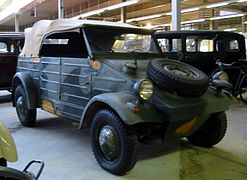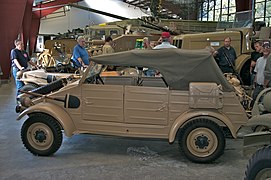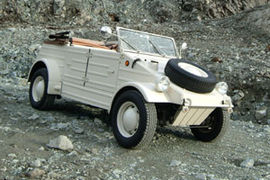Volkswagen Kübelwagen
This article includes a list of general references, but it remains largely unverified because it lacks sufficient corresponding inline citations. (September 2009) |
| VW type 82 "Kübelwagen" | |
|---|---|
 | |
| Overview | |
| Manufacturer | Volkswagenwerk GmbH |
| Also called | Safari, 'Bucket/Tub car' |
| Production | 50,435 (1940–1945) |
| Assembly | Stadt des KDF-Wagens, today Wolfsburg |
| Designer | Ferdinand Porsche |
| Body and chassis | |
| Class | Military vehicle |
| Body style | 4-door utility roadster |
| Layout | RR layout |
| Platform | VW Type 1 Kdf-Wagen |
| Related | VW 87 Kommandeurswagen VW 166 Schwimmwagen VW 276 Schlepperfahrzeug |
| Powertrain | |
| Engine | air-cooled flat-4, 985 cc (23.5 bhp (17.5 kW))/ 1,131 cc (25 bhp (19 kW)) |
| Transmission | 4-speed manual; self-locking differential portal gear reduction by 1.4:1 |
| Dimensions | |
| Wheelbase | 240 cm (7 ft 10 in) |
| Length | 374 cm (12 ft 3 in) |
| Width | 160 cm (5 ft 3 in) |
| Height | 165 cm (5 ft 5 in) (top up); 111 cm (3 ft 8 in) collapsible |
| Curb weight | 715 kg (1,576 lb) (GVW 1,160 kg) |
| Chronology | |
| Successor | DKW Munga (in German military) VW type 181 Thing / 182 Trekker |
The Volkswagen Kübelwagen (![]() listen (help·info)) (a back-formation of literally 'bucket' or 'tub' car),[1] or simply Kübel,[2] is a light military vehicle designed by Ferdinand Porsche and built by Volkswagen during World War II for use by the Nazi German military (both Wehrmacht and Waffen-SS). Based heavily on the Volkswagen Beetle, it was prototyped and first deployed in Poland as the Type 62, but following improvements entered full-scale production as the Type 82. Several derivative models, such as the Kommandeurswagen, were also built in hundreds, or in dozens.
listen (help·info)) (a back-formation of literally 'bucket' or 'tub' car),[1] or simply Kübel,[2] is a light military vehicle designed by Ferdinand Porsche and built by Volkswagen during World War II for use by the Nazi German military (both Wehrmacht and Waffen-SS). Based heavily on the Volkswagen Beetle, it was prototyped and first deployed in Poland as the Type 62, but following improvements entered full-scale production as the Type 82. Several derivative models, such as the Kommandeurswagen, were also built in hundreds, or in dozens.
Kübelwagen is a contraction of Kübelsitzwagen, meaning 'bucket-seat car'. Before the war, this term became popular in Germany, for light open-topped, cross-country and military vehicles without doors, because these were typically equipped with bucket seats, to help keep occupants on board, in an era before the adoption of seat belts.[3]:78,116,132,136[4] This body style had first been developed by in 1923.[3]:78 The first Porsche Type 62 test vehicles had no doors and were therefore fitted with bucket seats as Kübelsitzwagen, that was later shortened to Kübelwagen.[3]:136 Despite acquiring doors, and more regular, lower seats, the name "Kübelwagen" stuck, and was retained. Besides the Volkswagen plant, Mercedes-Benz, Opel, and Tatra also built Kübel(sitz)wagen,[5] – all of them rear-wheel drive only.
The Kübelwagen's rolling chassis and mechanics were built at what was then the Stadt des KdF-Wagens, ("City of the 'Strength through Joy'-Car") – renamed "Wolfsburg" after 1945 – and its body was built by U.S.-owned firm Ambi Budd Presswerke in Berlin.[6] The Kübelwagen's role as a light, multi-purpose military vehicle made it the German equivalent to the Allied Willys MB / Ford GPW "jeep" and the GAZ-67, after previous efforts to mass-produce standardized military four-wheel drives for the Wehrmacht had largely failed.
History[]


Although Adolf Hitler discussed with Ferdinand Porsche the possibility of military application of the Volkswagen as early as April 1934, it was not until January 1938 that high-ranking Third Reich army officials formally approached Porsche about designing an inexpensive, light-weight military transport vehicle, that could be operated reliably both on- and off-road, in even the most extreme conditions. This implied that the Beetle could provide the basis for such a vehicle.
Porsche began work on the project immediately, having a prototype of the vehicle ready within the month, but realized during development that it would not be enough to just reinforce the Beetle's chassis to handle the stresses that military use would place on it. In order to guarantee adequate off-road performance of a two-wheel-drive vehicle with a 1,000 cc FMCV 1 engine, it would have to be lightweight. In fact, the army had stipulated a laden weight of 950 kg (2,090 lb), including four battle-dressed troops, which meant that the vehicle itself should not weigh more than 550 kg (1,210 lb). Porsche therefore sub-contracted , an experienced military coachbuilder, to help out with the body design.
Developmental testing by the military began after a presentation of the prototypes designated as Type 62 in November 1938. Despite lacking four wheel drive, the vehicle proved very competent at maneuvering its way over rough terrain, even in a direct comparison with a contemporary standard German Army 4×4, and the project was given the green light for further development. The vehicle's light weight and ZF self-locking differential compensated for the lack of 4×4 capabilities.
Further development of the Type 62 took place during 1939, including a more angular body design, and pre-production models were field-tested in the invasion of Poland, that started in September that year. Despite their overall satisfaction with the vehicle's performance, military commanders demanded that a few important changes be made: the lowest speed of the vehicle had to be reduced from 8 km/h (5.0 mph) to 4 km/h (2.5 mph) as an adjustment to the pace of marching soldiers.[note 1] Second, it needed some improvement of its off-road ability. Porsche responded to both requests by mounting new axles with gear-reduction hubs, providing the car with more torque and more ground-clearance all at once. Revised dampers, 41 cm (16 in) wheels, and a limited-slip differential, as well as countless small modifications, completed the specification. In order to reflect the changes, the vehicle was renamed Type 82.
Full-scale production of the Type 82 Kübelwagen started in February 1940, as soon as the VW factories had become operational. No major changes took place before production ended in 1945, only small modifications were implemented, mostly eliminating unnecessary parts and reinforcing some, which had proved unequal to the task. Prototype versions were assembled with four-wheel-drive (Type 86) and different engines, but none offered a significant increase in performance or capability over the existing Type 82 and the designs were never implemented. As of March 1943, the car received a revised dash and the bigger 1,131 cc engine, developed for the Schwimmwagen, that produced more torque and power than the original 985 cc unit. When Volkswagen production ceased at the end of the war, 50,435 Kübelwagen vehicles had been produced,[7] and the vehicle had proven itself to be surprisingly useful, reliable, and durable.
Long after the end of the war, VW resurrected the basic Kübelwagen design as the 1969 Type 181, developed for the German Federal Armed Forces and later also produced for the civilian market, known as "Thing" in the US, "Trekker" in the UK, and "Safari" in Mexico. Although similar in looks and design, almost no parts were interchangeable with the Type 82.
Intermeccanica of Canada has been producing a Kubelwagen replica since 1995.[8][9]
Technology and performance[]
When the German military took delivery of the first vehicles, they immediately put them to the test on- and off-road in snow and ice to test their capability at handling European winters. Several four-wheel-drive vehicles were used as reference points. The two-wheel-drive Kübelwagen surprised even those who had been a part of its development, as it handily out-performed the other vehicles in nearly every test. Most notably, thanks to its smooth, flat underbody, the Kübel would propel itself much like a motorised sled, when its wheels were sinking into sand, snow, or mud, allowing it to follow tracked vehicles with remarkable tenacity.

In November 1943, the U.S. military conducted a series of tests as well on several Type 82s they had captured in North Africa campaign. This evaluation, done at the Army's Aberdeen Proving Ground[clarification needed], resulted in the publication of War Department Technical Manual TM E9-803, 6 June 1944. It was intended for distribution after the 6 June invasion of Normandy to US military personnel who might encounter ones that had been abandoned, possibly for lack of fuel or a minor technical problem, and with the help of this manual, might be put into service as additional vehicles. So thorough was the analysis that it included information beyond what could be done as field servicing, plus ways of dealing with very low temperatures. U.S. War Department Technical Manual TM-E 30-451, Handbook on German Military Forces, (p. 416), states: "The Volkswagen, the German equivalent of the American "Jeep", is inferior in every way except in the comfort of its seating accommodations."[10] Nevertheless, VW Kübelwagens were so frequently captured, and deemed sufficiently useful, that the same U.S. War Department wrote and published an official Technical Manual TM E9-803 for it in June 1944, for the benefit of allied officers and troops.

At the same time, another Kübelwagen, also captured in North Africa, had been dissected in Britain by engineers of the Humber Car Company, whose report said it exhibited no "special brilliance" in design except in details and that "it is suggested that it is not to be regarded as an example of first class modern design to be copied by British industry".[11]
Among the design features that contributed to the Kübelwagen's performance were:
- Light weight, although some 41 cm (16 in) longer than the Willys MB, it was over 300 kg (660 lb) lighter.
- Very flat and smooth underbody, that allowed the car to slide over the surface it was traversing.
- Considerable ground clearance, roughly 28 cm (11 in), in part thanks to:
- The use of portal gear hub reduction, providing more torque and ride height simultaneously.
- Independent suspension on all four wheels.
- Self-locking differential, limiting slippage and retaining traction.
In addition, the air-cooled engine proved highly tolerant of hot and cold climates, and was less vulnerable to bullets due to the absence of a radiator. For starting under winter conditions, a specially volatile starting fuel was required, contained in a small auxiliary fuel tank.
As the body was not a load-bearing part of the structure of the vehicle, it could easily be modified to special purposes, just like the jeep's.
The Kübelwagen could reach a top speed of 80 km/h (50 mph).
Variants[]


The following body types and variants of the Type 82 were produced:
- Type 62: Prototype Kübelwagen, constructed from 15 May 1938; pre-production models (1939) field tested in the invasion of Poland
- Type 67: 2-stretcher ambulance; Type 60 Beetle chassis with modified Type 82 body
- Type 82/0: Basic, standard four seater
- Type 82/1: Three-seater; usually radio car
- Type 82/2: Sirencar (Siemens motor-driven siren mounted on passenger side in place of the rear seat)
- Type 82/3: Mock-up scout car / armoured vehicle, incl. gun-turret atop cabin – for decoy and training purposes
- Type 82/5: Kübelwagen chassis, with Type 60/LO[note 2] Pritschenwagen (Beetle pickup-truck) body.[12]
- Type 82/6: "Tropenwagen": Kübelwagen chassis, with Beetle panel-van / box-van body
- Type 82/7: Three-seat 'Command car': a Type 82 chassis, fitted with a Beetle body and roll-up canvas roof section. These three-seaters had a single rear seat behind the driver, and a co-driver's seat with fully reclining backrest for a commanding officer.
- Type 82/8: Like regular open Type 82/0 Kübelwagen, but with body made of wood, to save on scarce steel resources
- Type 82/E:[note 3] "Geländekäfer": Kübelwagen chassis with Beetle body (688 manufactured)
- Type 86: Four-wheel drive (six prototypes made)
- Type 87: "Kommandeurwagen": a Type 86 4WD Kübelwagen chassis with Beetle command car body. Fitted with running boards, under-hood-mounted spare tire (accompanied by a gas can, a jack, a small tool kit, and a shovel), and widened fenders for its larger-diameter Kronprinz (Crown Prince) off-road tires. Some were provided to high-ranking officers, who could push through virtually any kind of terrain with them. (667 produced)[13][14]
- Type 89: Fitted with experimental automatic transmission
- Type 92/LO:[note 2] deprecated — from April 1943 known as Type 82/5 [15]
- Type 92/O: "offen": Kübelwagen chassis, with Type 60/O (Beetle convertible) body
- Type 92/SS: (until April 1943): with interior attachments for fire-arms — from April 1943 deprecated, and known as Type 82/E [15]
- Type 98: Beetle body with roll-up roof, on the Type 86 Kübelwagen 4×4 drive train
- Type 106: Fitted with an experimental transmission (assumed different from the Type 89)
- Type 107: Fitted with a turbocharger
- Type 115: Fitted with a supercharger
- Type 126: Fitted with a fully synchronized gearbox (assumed different from the Type 278)
- Type 155/1: Half-track / snow-track Kübelwagen prototype. Pictures of several track-set designs exist,[16] although it is possible, that these were consecutively fitted to the same prototype. Trials proved, that the Type 155 was able to cover the most difficult terrain, but the modifications necessary to the standard Kübelwagen were extensive and the resulting vehicle was both very slow and forbiddingly inefficient.
- Type 157: Railway car equipment, used for Types 82 and 87
- Type 164: Six-wheeled, twin engine, dual-control prototype; never entered production
- Type 177: Fitted with a five-speed transmission (as opposed to the standard four-speed unit)
- Type 179: Fitted with fuel-injected Volkswagen engine
- Type 179-F: Later updated directly to the Schwimmwagen (mentioned above)—Could cross water and temporarily be used as a small boat and/or landing craft. Because of a thick and bulletproof skid plate, the engine was protected and all valves in the rear were airtight. The engine had a flush-activated 179 fuel injected engine, that would act as a drainer to push water out and prevent the engine from flooding.
- Type 198: Fitted with a PTO and auxiliary gearbox for starting the engines of armoured fighting vehicles[17]
- Type 235: Fitted for power by an electric motor
- Type 239: Fitted for power by a wood-gas generator mounted on the nose (also listed as Type 230)
- Type 240: Fitted for power by bottled gas
- Type 276: "Schlepperfahrzeug": Type 82 fitted with a towing hook to pull a 3.7 cm 'PaK 36' gun[18]
- Type 278: Fitted with synchronized gearbox
- Type 307: Fitted with a heavy-duty carburetor
- Type 309: Prototype fitted with a diesel engine
- Type 331: Prototype fitted for power by a "native fuel system" (acetylene gas) engine (also listed as Type 231)
- Type 332: Fitted for power by anthracite coal
Gallery[]

1943 Kübelwagen in grey camouflage

Type 82 on display at the

Interior detail

Side profile

Type 82 replica built by Intermeccanica
See also[]
- Einheits-PKW der Wehrmacht
- Military light utility vehicle
- Volkswagen Beetle
- Volkswagen Schwimmwagen
- Volkswagen 181
- FMC XR311
- Mercedes-Benz 170 VK
- Tatra 57K
Notes[]
- ^ The German army was not fully mechanised and most troops moved on foot or by horse
- ^ Jump up to: a b LO for "Lieferwagen offen"
- ^ From April 1943. Until then known as Type 92 (SS) for closed body, or 92/O(ffen) for convertible.
References[]
- Mayer-Stein, Dr. Hans-Georg (1993). Volkswagen Militärfahrzeuge 1938–1948 (PDF) (in German). Karl Müller Verlag. ISBN 3860708619. Retrieved 7 August 2021.
- ^ Heitmann; et al. "German Weapons during WWII". Feldgrau. Retrieved 8 August 2021.
..Kübel meaning tub, bucket, or pail.
- ^ Bishop, Chris (2002). The Encyclopedia of Weapons of World War II. Sterling Publishing. pp. 102–103. ISBN 9781586637620. Retrieved 5 August 2021.
- ^ Jump up to: a b c Ludvigsen, Karl (2018). Professor Porsche's Wars. UK: Pen & Sword Books, Ltd. ISBN 9781526726797. Retrieved 14 February 2019.
- ^ Mayer-Stein (1993), p. 22.
- ^ Mayer-Stein, H.G. (1991), Volkswagens of the Wehrmacht: A Photo Chronicle, Stuttgart: Schiffer, p. 5, ISBN 978-0-88740684-3
- ^ "The Weird and Wonderful pt4 Military VWs", Wheelspin, UK: LTV VWC, July 2000, archived from the original on 9 December 2014, retrieved 16 April 2012.
- ^ http://mitglied.lycos.de/Geschichtsverein/vwik.html[permanent dead link]
- ^ "2009 EU Titled Liquid Cooled TYP82 Kubelwagen". Intermeccanica. Archived from the original on 25 December 2019. Retrieved 25 December 2019.
- ^ "Our Models". Intermeccanica. Archived from the original on 25 December 2019. Retrieved 25 December 2019.
- ^ U.S. War Department, 15 March 1945. Handbook on German Military Forces, TM-E 30-451, Chapter VIII, Section II: Automotive Equipment
- ^ "Report of examination of a German Light Aid Detachment Vehicle type VW82", published by Humber Car Co. in 1943 (GB)
- ^ "VW-Typ 825 (WH) in 1/35". www.panzerbaer.de.
- ^ Branch, Ben (26 April 2012). "Volkswagen Kommandeurwagen".
- ^ "VW Kommandeurwagen Type 87". Archived from the original on 2 February 2015. Retrieved 2 February 2015.
- ^ Jump up to: a b Mayer-Stein (1993), p. 30–31.
- ^ Mudway, Ray (February 1999). "The V.W. Typ-155 Half-Track Kübelwagen". Geocities. Archived from the original on 3 November 1999. Retrieved 14 February 2019.
- ^ "Typ198 Anwerfgetriebe fur Kfz. Motoren" published by Oberkommando der Heere in 1944, Berlin (D)
- ^ "Der VW Kübelwagen Typ 82 im Zweiten Weltkrieg" by Janusz Piekalkiewicz, published by Motorbuch, Stuttgart in 2002 ISBN 3-87943-468-9
Further reading[]
- Taylor, Blaine (2004). Volkswagen Military Vehicles of the Third Reich. Cambridge, Massachusetts: Da Capo Press. ISBN 0-306-81313-0. OCLC 55534990.
External links[]
| Wikimedia Commons has media related to Volkswagen Kübelwagen. |
- Kübelwagen Restoration with many details
- Kübelwagen Registry
- Volkswagen Kübelwagen Technical Manual TM E9-803, US War Department, June 1944
- Intermeccanica Kübelwagen
- World War II vehicles of Germany
- Volkswagen Beetle
- Goods manufactured in Germany
- Rear-engined vehicles
- Cars powered by boxer engines
- Military light utility vehicles
- Military vehicles introduced in 1940–1944





